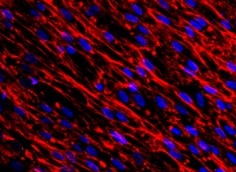Human Fibronectin Antibody Summary
Applications
Please Note: Optimal dilutions should be determined by each laboratory for each application. General Protocols are available in the Technical Information section on our website.
Scientific Data
 View Larger
View Larger
Fibronectin in WS-1 Human Cell Line. Fibronectin was detected in immersion fixed WS-1 human fetal skin fibroblast cell line using 10 µg/mL Mouse Anti-Human Fibronectin Monoclonal Antibody (Catalog # MAB19181) for 3 hours at room temperature. Cells were stained with the NorthernLights™ 557-conjugated Anti-Mouse IgG Secondary Antibody (red; Catalog # NL007) and counter-stained with DAPI (blue). View our protocol for Fluorescent ICC Staining of Cells on Coverslips.
Preparation and Storage
- 12 months from date of receipt, -20 to -70 °C as supplied.
- 1 month, 2 to 8 °C under sterile conditions after reconstitution.
- 6 months, -20 to -70 °C under sterile conditions after reconstitution.
Background: Fibronectin
Fibronectin (FN) is a large, modular glycoprotein that generates a polymeric fibrillar network in the extracellular matrix (ECM) and forms soluble, disulfide-linked dimeric protomers in plasma and other body fluids (1, 2). Fibronectin is a ligand for many molecules including fibrin, heparin, chondroitin sulfate, collagen/gelatin, and integrins. It is involved in multiple cellular processes such as cell adhesion/migration, blood clotting, morphogenesis, tissue repair, and cell signaling. Fibronectin functions are mediated by the insoluble polymeric fibrillar network. Conversion of soluble Fibronectin to Fibronectin fibrils in the ECM is initiated by binding to cell surface integrins, resulting in exposure of cryptic epitopes necessary for polymerization (1). Fibronectin is made up of three types of homologous structural motifs termed FN type I, type II, and type III repeats (3-5). Alternative splicing generates multiple isoforms of Fibronectin which may have insertions of extra type III domains (EDA and EDB) or alteration of the type III connecting segment (IIICS) (5). Differential splicing within the IIICS domain determines the presence of CS1 and CS2 sequences and its sensitivity to proteases (6, 7). The tilt angle between type III domains #9 and #10 (which contains an RGD motif) determines integrin binding affinity, suggesting how structural differences between fibrillar and soluble Fibronectin may influence their function (8). From the N-terminus to the furin cleavage site at amino acid 1908, human Fibronectin shares 92% amino acid sequence identity with mouse and rat Fibronectin.
- Mao, Y. and J.E. Schwarzbauer (2005) Matrix Biol. 24:389.
- Potts, J.R. and I.D. Campbell (1996) Matrix Biol. 15:313.
- Bernard, M.P. et al. (1985) Biochemistry 24:2698.
- Kornblihtt, A.R. et al. (1983) Proc. Natl. Acad. Sci. USA 80:3218.
- Kornblihtt, A.R. et al. (1985) EMBO J. 4:1755.
- Mould, A.P. et al. (1991) J. Biol. Chem. 266:3579.
- Abe, Y. et al. (2005) Biochem. Biophys. Res. Commun. 338:1640.
- Altroff, H. et al. (2004) J. Biol. Chem. 279:55995.
Product Datasheets
Citations for Human Fibronectin Antibody
R&D Systems personnel manually curate a database that contains references using R&D Systems products. The data collected includes not only links to publications in PubMed, but also provides information about sample types, species, and experimental conditions.
2
Citations: Showing 1 - 2
Filter your results:
Filter by:
-
Targeting a Designer TIMP-1 to the Cell Surface for Effective MT1-MMP Inhibition: A Potential Role for the Prion Protein in Renal Carcinoma Therapy
Authors: B Jiang, J Liu, MH Lee
Molecules, 2019-01-11;24(2):.
Species: Human
Sample Types: Whole Cells
Applications: ICC -
Induction of immunoregulatory CD271+ cells by metastatic tumor cells that express human endogenous retrovirus H.
Authors: Kudo-Saito C, Yura M, Yamamoto R, Kawakami Y
Cancer Res, 2014-03-01;74(5):1361-70.
Species: Human
Sample Types: Whole Cells
Applications: ICC
FAQs
No product specific FAQs exist for this product, however you may
View all Antibody FAQsReviews for Human Fibronectin Antibody
Average Rating: 5 (Based on 1 Review)
Have you used Human Fibronectin Antibody?
Submit a review and receive an Amazon gift card.
$25/€18/£15/$25CAN/¥75 Yuan/¥2500 Yen for a review with an image
$10/€7/£6/$10 CAD/¥70 Yuan/¥1110 Yen for a review without an image
Filter by:





